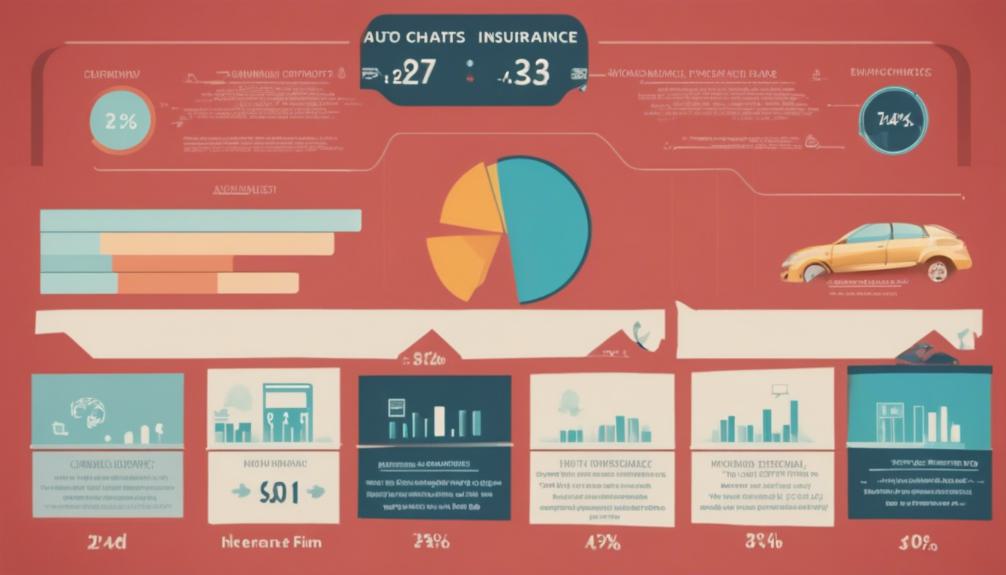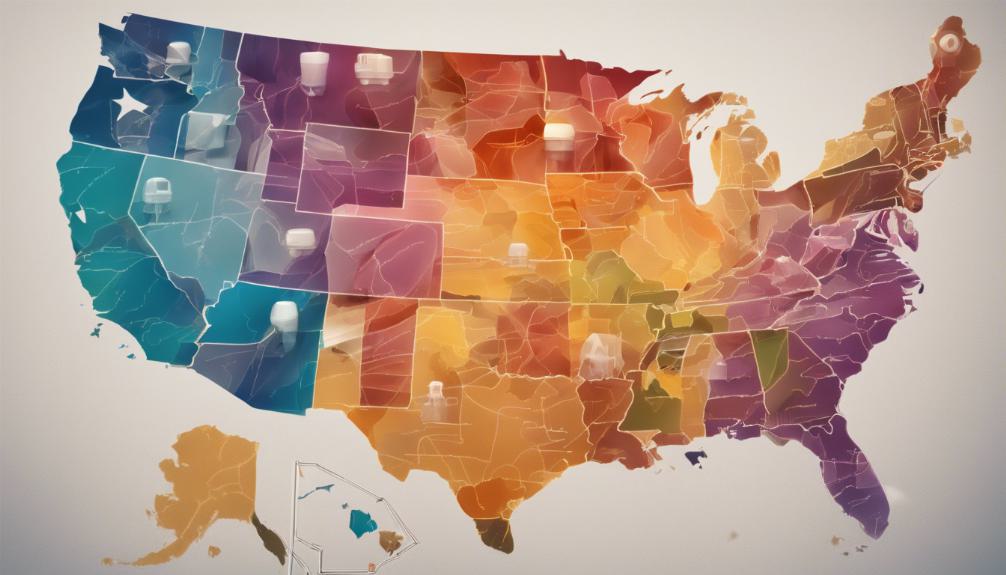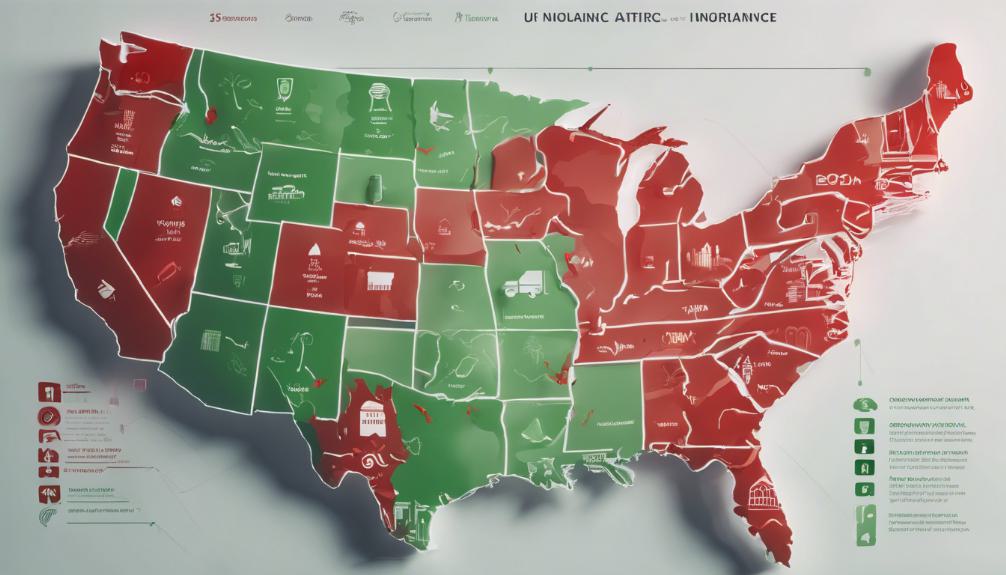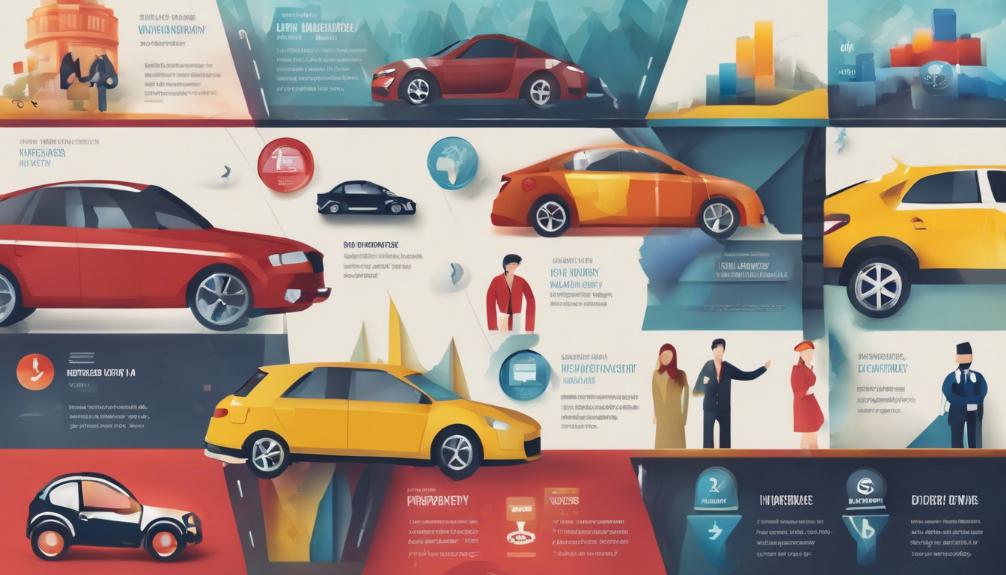Auto Insurance: Trends and Insights Unveiled
In recent years, the auto insurance landscape has undergone significant shifts, with some of us feeling the pinch more than others. We've navigated through a maze of changing rates and discovered intriguing patterns regarding affordability and provider competitiveness across the United States. As we explore the data from 2011 to 2020, we find ourselves at a crossroads, examining how states like Louisiana and Michigan contrast sharply with places like Iowa regarding insurance costs. Our analysis doesn't stop there; we also take a closer look at the heavyweights of the insurance industry and their strategies. Join us as we peel back the layers of this complex industry, uncovering insights that could reshape how we think about auto insurance.

Key Takeaways
- Auto insurance expenditures have steadily increased from 2011 to 2015, highlighting a growing cost for vehicle owners.
- States like Louisiana and Florida are among the least affordable for auto insurance, emphasizing geographic disparities in costs.
- State Farm Mutual Automobile Insurance leads in private passenger auto insurance by direct premiums written in 2022, indicating market dominance.
- The auto insurance market includes specialized segments for high-risk drivers, offering options beyond standard market offerings.
Spending Patterns Revealed

We've observed that over the past decade, average expenditures for auto insurance have steadily increased, climbing from $795.01 in 2011 to $896.66 in 2015. This rise reflects not just inflation but also changes in driving habits, vehicle technology, and regulatory environments. As stewards of our communities, it's important we comprehend these trends to better serve those we're committed to helping. The consistent increase in costs can strain budgets, especially for families prioritizing safety and compliance. We're focused on finding solutions that balance affordability with the necessary protection auto insurance provides. By staying informed on these patterns, we can advocate for and implement strategies that ease the financial burden on our community members, ensuring they're both safe on the roads and financially secure.
State-by-State Expenditures

After exploring general spending trends, let's focus on how auto insurance expenditures vary from state to state. It's apparent that where you live greatly impacts what you pay. For example, residents in Louisiana, New York, and Michigan face the steepest bills, reflecting complex risk factors and regulatory environments unique to those areas. Conversely, folks in North Dakota, Maine, and Iowa enjoy the most affordable rates. This state-by-state disparity highlights the importance of understanding local factors that drive costs. As we aim to serve our communities better, recognizing these differences enables us to provide more tailored advice and support, helping everyone navigate the sometimes-confusing world of auto insurance with greater ease and confidence.
Affordability Across the U.S

Exploring auto insurance affordability across the U.S reveals that spending varies greatly from state to state, with some households allocating a larger portion of their income to this necessity than others. We've noticed that in states like Louisiana, Florida, and Michigan, families find it particularly challenging to afford auto insurance, as these areas rank lowest with regards to affordability. Conversely, places like Iowa shine as beacons of affordability, offering some relief to their residents. This discrepancy highlights the pressing need for solutions that cater to the financial well-being of all families, irrespective of where they live. Our goal is to advocate for policies and practices that guarantee everyone has access to affordable auto insurance, making our roads safer and relieving financial stress for families nationwide.
Leading Insurance Providers

Several top insurers dominate the private passenger auto insurance market, led by giants such as State Farm Mutual Automobile Insurance and Progressive Corp. Alongside them, Berkshire Hathaway Inc., Allstate Corp., and USAA Insurance Group play pivotal roles. We're committed to guiding our community through the often complex terrain of choosing the right insurer. Understanding the landscape, these leading companies offer a variety of coverage options and customer service experiences. It's important for us to help others navigate their way toward the best fit for their needs, ensuring they're not only protected on the road but also receiving the value and support they deserve. Our aim is to empower those we serve with knowledge, making their journey in selecting auto insurance a bit easier and more informed.
Types of Auto Claims

Moving from our discussion on leading insurance providers, let's now focus on the various types of auto claims you might encounter. In our commitment to serving our community, we recognize that steering through auto insurance claims can be challenging. In essence, there are three main types of claims: liability, collision, and inclusive. Liability claims cover damages you're legally responsible for, offering peace of mind if you're at fault in an accident. Collision claims address damages to your vehicle from an accident, regardless of fault. Inclusive claims cover non-collision incidents, such as theft, vandalism, or natural disasters. We're here to guide you through understanding these claims, ensuring you're well-prepared to support those in need with the right information at the right time.
Claims Frequency and Severity

Understanding the nuances of claims frequency and severity is crucial for evaluating auto insurance trends effectively. We've observed that while the frequency of claims may fluctuate, the severity—or the cost associated with these claims—tends to increase. This trend directly impacts how we serve our clients, ensuring they receive thorough coverage without sacrificing affordability. We're committed to analyzing these patterns to advise our clients accurately, helping them navigate the complexities of auto insurance with ease. Our goal is to empower them with knowledge, ensuring they're not only protected on the road but also financially secure. By staying informed about these trends, we're better equipped to serve our community, offering solutions that truly meet their needs.
Collision and Comprehensive Insights

Building on our discussion of claims frequency and severity, we'll now explore the intricacies of collision and all-encompassing insurance coverage. We've seen how these coverages serve as crucial components of a robust auto insurance policy, providing peace of mind to our clients. Collision insurance steps in when a vehicle is damaged from an accident with another vehicle or object, ensuring that our clients aren't left stranded financially. All-encompassing coverage, on the other hand, addresses damages from non-collision events like theft, fire, or natural disasters. It's our mission to guide our clients through these complexities, ensuring they're well-informed and adequately protected. By understanding the nuances of these coverages, we can better serve our community, offering solutions that meet their unique needs and circumstances.
Market Segmentation Overview

In the domain of auto insurance, market segmentation plays a pivotal role, enabling insurers to cater to a diverse range of driver needs and risk profiles. We've observed how this approach allows us to serve our communities better by understanding and addressing the unique circumstances of each driver. Whether it's a family looking for full coverage for their newest driver or an individual seeking basic liability protection, segmentation empowers us to tailor our offerings. This strategy guarantees that everyone, regardless of their driving history or vehicle type, has access to policies that suit their specific requirements. By dividing the market into distinct segments, we're not just selling insurance; we're providing peace of mind and fostering safer driving environments for all.
High-Risk Coverage Options

Exploring the domain of auto insurance further, we now focus on high-risk coverage options available for drivers facing challenges obtaining standard policies. We comprehend that everyone's journey on the road varies, and some of us encounter more bumps along the way. That's where high-risk coverage comes into play, offering a safety net for those who've had multiple traffic violations, DUIs, or have been involved in numerous accidents. It's our goal to make certain that every driver, regardless of their past driving history, has access to the protection they need. We're here to guide you through the process, helping you find a policy that fits your unique situation. Let's work together to keep you safely on the road, no matter what your driving record looks like.
Frequently Asked Questions
How Do International Auto Insurance Rates Compare to Those in the United States?
We're curious about how international auto insurance rates stack up against those in the U.S. It's essential for us to understand these comparisons to better serve our community with informed choices and support.
What Are the Environmental Impacts of Auto Insurance Policies, and Are There Any "Green" Insurance Options?
We're steering through the murky waters of auto insurance's environmental impact, seeking 'green' options to anchor our values in sustainability. It's like choosing the cleanest fuel for a journey that benefits us all.
How Has the Rise of Autonomous Vehicles Affected Auto Insurance Premiums and Policy Structures?
We've noticed autonomous vehicles are changing the game for auto insurance premiums and policy structures, leading us to rethink our offerings and how we serve our clients in this new, evolving landscape.
Can Telematics and AI Significantly Reduce Fraud in Auto Insurance ClAIms, and What Are the Privacy Concerns Associated With Their Use?
We're steering through a stormy sea of data, believing telematics and AI can indeed curb fraud in auto insurance claims. However, we're mindful of the privacy concerns these technologies bring to the forefront.
How Do Socioeconomic Factors and Urbanization Trends Impact Auto Insurance Rates Beyond the State Level, for Example, in Rural Vs. Urban Areas?
We've noticed that socioeconomic factors and urbanization greatly affect auto insurance rates, especially when comparing rural to urban areas. It's important we explore how these elements influence costs to better serve our communities.

This post has been generated by AI and was not reviewed by editors. This is Not legal advice. Please consult with an attorney.




